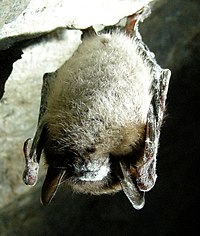
Photo from wikipedia
In the United States, the discovery and spread of white-nose syndrome (WNS) has drastically changed how bats and caves are managed. The U.S. National Park Service has been instrumental in… Click to show full abstract
In the United States, the discovery and spread of white-nose syndrome (WNS) has drastically changed how bats and caves are managed. The U.S. National Park Service has been instrumental in the national response to WNS, as it manages extensive cave resources and has a close relationship with the public. However, managers lack information on visitor support for disease prevention measures designed to slow the spread of WNS and minimize human disturbance of vulnerable bat populations. This study utilized the Theory of Planned Behavior to determine how visitor attitudes, subjective norms, and perceived behavioral controls influenced their behavior regarding WNS preventive actions, including participation in educational programming on bats, wearing clothes or shoes in caves that have not been contaminated with the fungus that causes WNS, walking over decontamination mats, and complying with cave closures. During summer of 2019, data were collected using an on-site survey of 1365 visitors to eight U.S. national park units: Oregon Caves, Lava Beds, Carlsbad Caverns, El Malpais, Wind Cave, Jewel Cave, Mammoth Cave, and Cumberland Gap. Visitors were willing to participate in all preventative actions addressed in the survey (77.7%-96.7%). Visitors expressed that engaging in these actions was very desirable (36.0%-65.6%), and their decision to engage in these actions was most strongly influenced by park staff (39.2%-68.8%) or signage (35.5%-61.9%). Attitudes and subjective norms were positive predictors of behavioral intentions for all measures. Perceived behavioral control was not a direct predictor for behavioral intent, but its interaction with attitudes and subjective norms had a moderating influence on intention to comply with multiple WNS preventive actions. With the continued spread of WNS and emergence of other threats to bats, understanding visitor behavioral intent and underlying factors will facilitate successful implementation of preventive actions that are publicly supported and promote conservation of bat populations in U.S. national parks.
Journal Title: PLOS ONE
Year Published: 2022
Link to full text (if available)
Share on Social Media: Sign Up to like & get
recommendations!